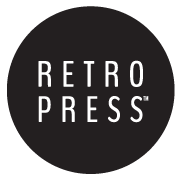Preparing Files for Letterpress
Providing finished artwork for Letterpress printing is unique to all other printing methods. At Retro Press we pride ourselves on giving our clients the very best product. To help us achieve perfection here are some hints to ensure your designs can be reproduced using Letterpress.
Typography
- – All fonts need to be set 6pt or larger for the best reproduction. If you have type smaller than 6pt please contact us.
- – If there is reverse type on a solid fill the font needs to be larger than 7pt (see below for guidelines on using solid fill)
- – Any thin strokes and terminals usually found in scripts & italics need to all be greater than 0.25pt
- – To allow for the impression made into the paper, tracking needs to be increased to at least +5
- – All text is to be converted to curves / paths
- – Any isolated dots need to be 0.5pt or thicker
Images
- – If using hand-drawn art or other images being scanned all images must be converted to line art.
- – Scanned images must be supplied at a minimum of 300dpi at 100% in size. Higher resolution up to 600dpi is preferable.
- – Image files need to be converted to bitmap mode. Note that any subtle tonal variations that are in your original artwork won’t show up once converted to bitmap.
- – Single colour half tone images need to be 100dpi or coarser and look best on uncoated paper that will give that heavy dot, newspaper-like old look.
The Use of Solid Fill
- – The use of solid fill ie the coverage of ink in your artwork, needs to be carefully considered. Letterpress can’t always successfully reproduce large block areas of colour.
- – A large ink coverage will limit the amount of impression into the stock. If a solid larger than the size of business card is required please contact us for some feedback.
Colours
- – You must ensure that only Pantone uncoated spot colours are used in your design.
- – Letterpress will not recognise CMYK or RGB Colours
- – Black Ink should be set as Process Black Uncoated Swatch
- – It is not possible to print white ink on a black or dark coloured stock. The dark colour stock will show through the white ink. If you would like to use a dark coloured paper then a hot foil or in some cases a metallic ink would be recommended.
- – While designing, get a feel on-screen for how overlapping printed colours will look by setting the Blending Mode to Multiply in the Transparency Palette.
- – You can also play with the Opacity level to help decide whether you want a lighter ‘kiss’ impression or heavier impression. See below for tips on Bite & Kiss.
- – Some of the best letterpress work is printed in one or two colours. Good ideas, design, typography and paper choice sometimes become the hero over the colour. However, three, four or more carefully chosen spot colour combinations are very achievable and can look spectacular.
- – Letterpress Inks are translucent. When printed one on top of another you get the appearance of a third colour where overlapping occurs. Light colours can be printed over dark colors or vice versa to eye-catching affect.
Bite & Kiss
- – The depression or indentation that happens in the paper’s surface when the image is letterpressed with a heavy impression weight is referred to as bite.
- – The bite is a large factor of what sets letterpress apart from other forms of printing.
- – The amount of bite must be carefully considered.
- – A heavy bite on the front of most paper stocks will show through to the back, this isn’t an issue as long as it is considered in the design process.
- – The thinner the stock the more bite you will get on the back and vice versa.
Blind Impression
- – With letterpress you can use an inkless blind impression where the image is created with just a bite impression in the paper surface.
- – The best impact for blind impression is to use a heavy weighted stock and larger type faces or images.
Artwork Submission Summary
- – Artwork as PDF files are only accepted and all fonts have set to paths.
- – Artwork needs to include 3mm bleed and crop marks. Large isolated crop marks are not acceptable. Don’t include any colour bars or page info. Registration marks may be required for foiling plates please contact us.
- – Artwork needs to be spot colour only no cmyk images will be accepted.
- – Please supply single colour spot pdf files in selected pms as well as a separate process black pdf file. Any two colour pdf files should be sent in selected spot pms as well as a separate process black and cyan pdf file.
- – Send all artwork through to andrew@retropress.com.au
